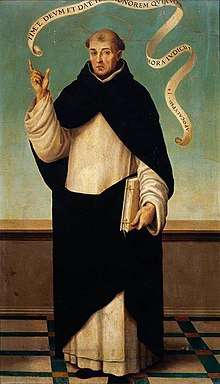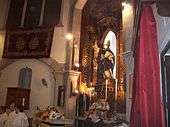Vincent Ferrer
Saint Vincent Ferrer, o.p. (Valencian: Sant Vicent Ferrer [ˈsam viˈsɛm feˈreɾ]; 23 January 1350 – 5 April 1419) was a Valencian Dominican friar, preacher, who gained acclaim as a missionary and a logician. He is honored as a saint of the Catholic Church and other churches of Catholic traditions.
Saint Vincent Ferrer OP | |
|---|---|
 San Vicente Ferrer by Juan de Juanes | |
| Priest Angel of the Last Judgment | |
| Born | 23 January 1350 Valencia, Kingdom of Valencia |
| Died | 5 April 1419 (aged 69) Vannes, Duchy of Brittany |
| Venerated in | |
| Canonized | 3 June 1455, Santa Maria sopra Minerva, Papal States by Pope Callixtus III |
| Major shrine | Cathedral of Vannes Vannes, Morbihan, France, Bogo City, Cebu, Philippines, Banay-banay,[1] Lipa City, Philippines, in Iglesia Filipina Independiente (IFI) Diocesan Shrine in Old Town San Remigio, Antique, Philippines and IFI Cathedral in Odiongan, Romblon, Philippines. |
| Feast | 5 April |
| Attributes | |
| Patronage |
|
Early life

Vincent was the fourth child of the nobleman Guillem Ferrer, a notary who came from Palamós, and wife, Constança Miquel, apparently from Valencia itself or Girona.[2][3][4][5] Guillem Ferrer's family was of English-Scottish Catholic noble origin,[6] coming to Valencia in the 13th century and being ennobled once more by James I of Aragon, and in some sources his name is given as William Stewart Ferrer, referring to his descent also from the Stewarts of Scotland.[7][8]
Legends surround Vincent's birth. It was said that his father was told in a dream by a Dominican friar that his son would be famous throughout the world. His mother is said never to have experienced pain when she gave birth to him. He was named after St. Vincent Martyr, the patron saint of Valencia.[9] He would fast on Wednesdays and Fridays and he loved the Passion of Christ very much. He would help the poor and distribute alms to them. He began his classical studies at the age of eight, his study of theology and philosophy at fourteen.[10]
Four years later, at the age of eighteen, Ferrer entered the Order of Preachers,[11] commonly called the Dominican Order, in England also known as Black Friars. As soon as he had entered the novitiate of the Order, though, he experienced temptations urging him to leave. Even his parents pleaded with him to do so and become a secular priest.[12] He prayed and practiced penance to overcome these trials. Thus he succeeded in completing the year of probation and advancing to his profession.
For a period of three years, he read solely Sacred Scripture and eventually committed it to memory. He published a treatise on Dialectic Suppositions after his solemn profession, and in 1379 was ordained a Catholic priest at Barcelona. He eventually became a Master of Sacred Theology and was commissioned by the Order to deliver lectures on philosophy. He was then sent to Barcelona and eventually to the University of Lleida, where he earned his doctorate in theology.[13]
Vincent Ferrer is described as a man of medium height, with a lofty forehead and very distinct features. His hair was fair in color and tonsured. His eyes were very dark and expressive; his manner gentle. Pale was his ordinary color. His voice was strong and powerful, at times gentle, resonant, and vibrant.[9]
Western Schism
The Western Schism (1378–1418) divided Roman Catholicism between two, then eventually three, claimants to the papacy. Antipope Clement VII lived at Avignon in France, and Pope Urban VI in Rome. Vincent was convinced that the election of Urban was invalid, although Catherine of Siena was just as devoted a supporter of the Roman pope. In the service of Cardinal Pedro de Luna, Vincent worked to persuade Spaniards to follow Clement. When Clement died in 1394, Cardinal de Luna was elected as the second antipope successor to the Avignon papacy and took the name Benedict XIII.[14]
Vincent was loyal to Benedict XIII, commonly known as "Papa Luna" in Castile and Aragon.[10] He worked for Benedict XIII as apostolic penitentiary and Master of the Sacred Palace.[14] Nonetheless Vincent labored to have Benedict XIII end the schism.[13] When Benedict XIII did not resign as intended at either the Council of Pisa (1409) or the Council of Constance (1414–1418), he lost the support of the French king and of most of his cardinals, and was excommunicated as a schismatic in 1417. Vincent encouraged King Ferdinand I of Aragon to withdraw his support from Benedict XIII.
Vincent later claimed that the Western Schism had had such a depressing effect on his mind that it caused him to be seriously ill.[15]
Religious gifts and missionary work
For twenty-one years he was said to have traveled to England, Scotland, Ireland, Aragon, Castile, France, Switzerland, and Italy, preaching the Gospel and converting many. Many biographers believe that he could speak only Catalan, but was endowed with the gift of tongues.[10]
He preached to St. Colette of Corbie and to her nuns, and it was she who told him that he would die in France. Too ill to return to Spain, he did, indeed, die in Brittany in 1419. Breton fishermen still invoke his aid in storms, and in Spain he is the patron of orphanages.[16]
Conversion of Jews and controversy
Vincent is said to have been responsible for the conversion of many Jews to Catholicism, often by questionable means according to the Jewish Encyclopedia; for instance, he is said to have made their lives difficult until they converted and to have "dedicated" synagogues as churches on the basis of his own authority.[17] One of his converts, a former rabbi by the name of Solomon ha-Levi, went on to become the Bishop of Cartagena and later the Archbishop of Burgos. Vincent is alleged to have contributed to anti-Semitism in Spain, as violence accompanied his visits to towns that had Jewish communities.[18]
Because of the Spanish's harsh methods of converting Jews at the time, the means which Vincent had at his disposal were either baptism or spoliation. He won them over by his preaching, estimated at 25,000.[10]
Sources are contradictory concerning Vincent's achievement in converting a synagogue in Toledo, Spain, into the Church of Santa María la Blanca. One source says he preached to the mobs whose riots led to the appropriation of the synagogue and its transformation into a church in 1391;[19] a second source says he converted the Jews of the city who then changed the synagogue to a church after they embraced the Faith, but hints at the year 1411.[13] A third source identifies two distinct incidents, one in Valencia in 1391 and one in Toledo at a later date, but says that Vincent put down an uprising against Jews in one place and defused a persecution against them in the other.[20] Vincent also attended the Disputation of Tortosa (1413–14), called by Avignon Pope Benedict XIII in an effort to convert Jews to Catholicism after a debate among scholars of both faiths.[18]
Compromise of Caspe
Vincent participated in the management of a significant political crisis in his homeland. King Martin of Aragon died in 1410 without a legitimate heir, and five potential candidates came forth to claim the throne, all with royal bloodlines. It was determined that a committee of nine respected figures, three each from Aragon, Catalonia, and Valencia (the realms comprising the Crown of Aragon), would review the qualifications and select the next king. Vincent was chosen as one of the representatives of Valencia, and he voted for the Castilian prince Ferdinand of Antequera, who became the next King of Aragon. The process by which Ferdinand was determined to be the next king is known as the Compromise of Caspe.
Death and legacy
Vincent died on 5 April 1419 at Vannes in Brittany, at the age of 69,[11] and was buried in Vannes Cathedral. He was canonized by Pope Calixtus III on 3 June 1455.[10] His feast day is celebrated on 5 April.[21]
Entities named after him include a pontifical religious institute, the Fraternity of Saint Vincent Ferrer; as well two Brazilian municipalities, São Vicente Ferrer, Maranhão and São Vicente Ferrer, Pernambuco.
A 50-metre (164-foot) statue of Ferrer was erected in Bayambang, Philippines in 2019.
See also
- Monastery of Sant Jeroni de Cotalba
- Saint Vincent Ferrer, patron saint archive
- Statues of Saints Vincent Ferrer and Procopius, Charles Bridge
References
- https://www.facebook.com/Archdiocesan-Shrine-Parish-of-St-Vincent-Ferrer-1228946467199020/?ref=ts&fref=ts
- "Sant Vicent Ferrer, patró de l'antic Regne de València", by Àngel Canet Català, Vilaweb, 31 March 2008, reprinted in Normalització, (in Catalan). The author of this article references El gran llibre dels sants, by Roger Costa Solé, Ara Llibres, Barcelona, 2007, as his source. Consulted 2016-12-18.
- Como una red. Sermones de Vicent Ferrer, by Josep-Antoni Ysern i Lagarda, University of Valencia, (in Spanish). Consulted 2016-12-18.
- "Notas sobre esta historia", in Historia de la portentosa vida y milagros del Valenciano Apostol de Europa San Vicente Ferrer, by Francisco VIDAL Y MICÒ and Serafin Thomas MIGUEL, Valencia, 1733, p. 453 (in Spanish). Consulted 2016-12-18.
- Dress, Clayton J. The Late Medieval Age of Crisis and Renewal, 1300–1500: A Biographical Dictionary. Greenwood Press, 2001. ISBN 0-313-30588-9. (p. 490)
- Fr. S.M.Hogan,"Saint Vincent Ferrer, O.P.". Longmans, Green and Co, London: 1911. Pp. 1-2
- CatholicIreland.net: "Apr 5 - St Vincent Ferrer (1350-1419)"
- Saint Vincent Catholic Church (p.12): "Short Biography of St. Vincent Ferrer"
- "Minnaji O.P., Cora. "Biography: The Life of St. Vincent Ferrer: The Wonder Worker". The Church of St. Vincent Ferrer, NYC". Archived from the original on 19 December 2013. Retrieved 1 February 2014.
- Reinhart, Albert. "St. Vincent Ferrer." The Catholic Encyclopedia. Vol. 15. New York: Robert Appleton Company, 1912. 11 Feb. 2015
- "St. Vincent Ferrer", Catholic News Agency
- International website of the Order of Preachers "St. Vincent Ferrer"
- "The Lives or the Fathers, Martyrs and Other Principal Saints by Rev. Alban Butler". Ewtn.com. Retrieved 17 December 2012.
- Foley OFM, Leonard, "St. Vincent Ferrer", Saint of the Day, Lives, Lessons, and Feast, (revised by Pat McCloskey), Franciscan Media ISBN 978-0-86716-887-7
- Hogan O.P., Stanislaus M., Saint Vincent Ferrer O.P., London: Longmans, Green and Co., 1911
- Website O.P.
- "Jewish Encyclopedia, Vincent Ferrer". Jewishencyclopedia.com. Retrieved 17 December 2012.
- The History of Anti-Semitism: From Mohammed to the Marranos – Léon Poliakov – Google Books. Books.google.com. Retrieved 17 December 2012.
- Despland, Michel. "La religion en Occident: Grandes ou petites vérités?" (in French). Encyclopédie de l'Agora. Retrieved 26 August 2007.
- Barrack, Marty, Second Exodus
- Drees, Clayton J. (2001). The Late Medieval Age of Crisis and Renewal, 1300-1500: A Biographical Dictionary. Greenwood Publishing Group. p. 490. ISBN 0313305889.
Further reading
Books
- Laura Ackerman Smoller, The Saint and the Chopped-Up Baby: The Cult of Saint Vincent Ferrer in Medieval and Early Modern Europe. (Ithaca, NY: Cornell University Press, 2014).
- The Life and Miracles of St. Vincent Ferrer: The "Angel of the Apocalypse"
- Andrew Pradel, St. Vincent Ferrer, of the Order of Friar Preachers: His life, spiritual teaching, and practical devotion, trans. by T. A. Dixon (London: R. Washbourne, 1875). (The French original received its imprimatur in 1863.)
Articles
- Albert Reinhart, 'St. Vincent Ferrer' in The Catholic Encyclopedia (New York: Robert Appleton Company, 1912).
- Chisholm, Hugh, ed. (1911). . Encyclopædia Britannica (11th ed.). Cambridge University Press.
- John Gilmary Shea, ‘Saint Vincent Ferrer’ in Little Pictorial Lives of the Saints (New York: Benziger Brothers, 1894).
- Terry H Jones, ‘Saint Vincent Ferrer’ in Saints.SQPN.com (Star Quest Production Network).
- ‘St. Vincent Ferrer’ in Saints and Angels (Catholic Online).
| Wikimedia Commons has media related to Saint Vincent Ferrer. |